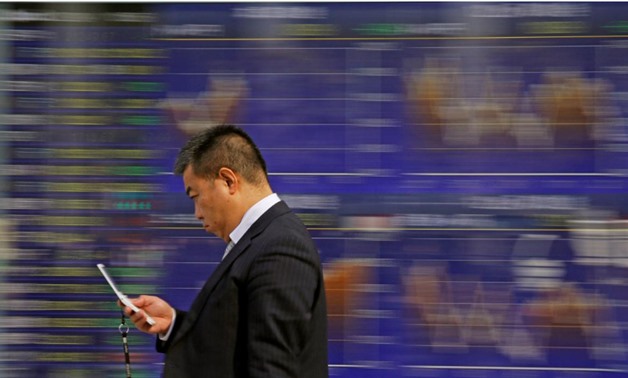
A man walks past an electronic stock quotation board outside a brokerage in Tokyo, Japan, February 9, 2018. REUTERS/Toru Hanai
SHANGHAI - 14 May 2019: World stocks hovered near two-month lows on Tuesday, although slightly more optimistic comments from U.S. and Chinese officials on trade brought some comfort a day after equities suffered their worst selloff so far this year.
Fears the United States and China are spiraling into a fiercer, more protracted trade dispute that could derail the global economy, has rattled share markets in recent weeks, and the selloff accelerated on Monday after China announced plans for retaliatory tariffs.
But the Chinese government’s top diplomat said China and the United States both have the “ability and wisdom” to reach a trade deal that is good for both. And U.S. President Donald Trump said he was optimistic about resolving the trade dispute.
That paved the way for a positive start for the European trading session, with stock markets in London, Frankfurt and Paris 0.6% to 0.9% higher, while U.S. stock futures rallied.
“The trade war is driving markets at the moment,” said Rory McPherson, head of investment strategy at Psigma Investment Management in London.
“Markets were prone to a selloff after a good start to the year on expectations of policy easing from central banks and no escalation of trade tensions, and it’s this latter pillar that has come away.”
China has said it would impose higher tariffs on $60 billion of U.S. goods in retaliate against a U.S. tariff hike on Chinese goods.
Asian shares took another beating on Tuesday but closed off their lows, following the more upbeat tone from U.S. and Chinese officials.
Japan’s Nikkei stock index fell to its lowest since mid-February, while broader Asian markets were dragged down by a selloff in Chinese shares.
MSCI’s broadest index of Asia-Pacific shares outside Japan fell over 1% to its lowest level since Jan 30, leaving MSCI’s world equity index stuck near its lowest levels in around two months.
Prakash Sakpal, Asia economist at ING in Singapore, said the current volatility showed how a “180-degree” turn in U.S. rhetoric on trade negotiations had spooked markets.
“We don’t see any quick end to this state of the markets until we see some resolution, constructive dialogue and something very solid in terms of deals. But the hopes for that are a bit misplaced currently,” he said.
Trump has said he would meet with Chinese President Xi Jinping next month, with focus now turning to an upcoming G20 meeting.
STABILIZATION?
Signs of stability in world equity markets took the shine off safe-haven assets for now.
Yields on 10-year German government bonds were two basis points higher on the day at minus 0.06% and off six-week lows hit on Monday when investors flooded into safe havens.
U.S. 10-year Treasury yields also rose away from Monday’s six-week lows, rising back above shorter-dated three-month bill yields after the yield curve inverted on Monday for the second time in less than a week.
That move underscored worries about the economic impact of a trade war, given a sustained inversion of this part of the yield curve has preceded every U.S. recession in the past 50 years.
The safe-haven yen too lost some ground as the mood improved, with the dollar strengthening 0.4% against the Japanese currency to 109.74.
The euro firmed 0.12% at $1.1235. However, China’s offshore yuan hit a fresh 2019 low in Asian trade before rebounding to trade at 6.8989 per dollar, up 0.2%.
Its counterpart strengthened slightly to 6.8731 per dollar after the four-month lows touched on Monday sparked speculation Beijing was letting the currency weaken amid the intensifying trade war.
Oil prices edged up, buoyed by Middle East tensions though gains were checked by trade war concerns. Brent crude gained 0.07% to $70.28 per barrel.
Gold prices held near one-month highs, trading steady on the day at around $1,298 per ounce.


Comments
Leave a Comment